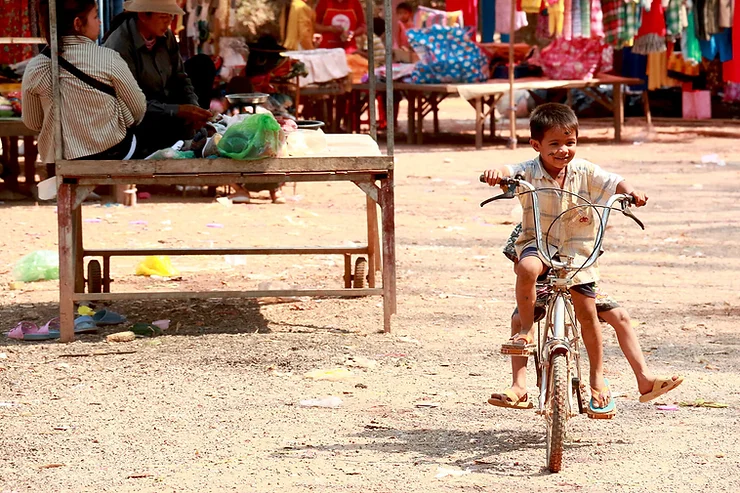I have just finished my trip to Cambodia and I am flooded with a flood of feelings and emotions to throw onto paper, a cocktail of delight with a syrupy touch of bitterness. I have spent a week visiting a country that is not the same as yesterday nor will it be the same as tomorrow. Tremendously beautiful as well as savagely devoured by the voracious appetite of tourists Cambodia is home to the spectacular Angkor Wat temple and is home to unique beaches and natural landscapes. But the unawareness of tourists and the greed of investors are rapidly devastating the natural charm of the country while destabilizing local society due to the impassiveness of local authorities. Thus, after seven days of fantastic adventure punctuated with outbursts of helplessness, I am going to share my sighs from Cambodia.
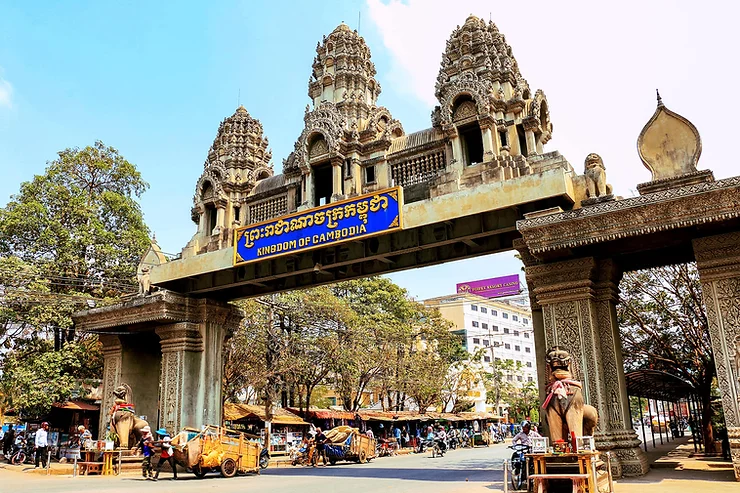

Poipet, border entry point to Cambodia from Thailand
I crossed from Thailand through the Poipet border crossing traveling by local bus, although the vast majority of passengers were foreigners. Five kilometers before reaching the border, the driver stops next to a restaurant and loudly announces that it is time to acquire the visa. Everyone gets out of the vehicle while I watch in amazement through the window as they hand their passports and a good wad of dollars to a couple of well-groomed locals behind a simple wooden table clearly placed improvised in the middle of the premises. After spending about thirty minutes exposed to the arteries of the locals, the travelers returned to the bus with passports in hand and pleasant smiles.
When talking to them, they told me that they had paid 40 dollars for the visa, when I had understood that it was only worth 20, but they had also paid an extra 3 dollars for the malaria test. ‘The malaria test?’ I asked strangely. It turns out that they had inserted a thermometer into their ears, ensuring that they needed to have a certificate proving that they did not carry the disease and that, of course, had its price. I had just discovered that there was a cutting-edge technology in a local restaurant in Cambodia that was capable of diagnosing malaria after inserting a thermometer in the ear, what things!
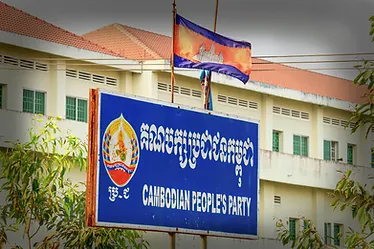

Flag and poster of the communist party of Cambodia
When we finally arrived at the border crossing, I soon realized that I was entering a commercial area. After crossing the border of Thailand and arriving at the border of Cambodia, where they had to stamp my passport (for those of us who had not ‘hired’ the improvised agency of the local restaurant), I found a window from which three police officers were leaning out and over which A sign read “Visa, $20.” I handed over my passport and a 20 dollar bill with a smile that was reciprocated with a cold look from the officers as they tapped their index finger on a sheet of paper taped to the counter: “20 dollars + 150 Baht” (150 Baht = 4 euros). My response was to lightly tap, still smiling, at the sign above them, “20 dollars.” As if it were a duel from the Wild West, they frowned and hit again, this time with more intensity, the little sign stuck on the counter that required a small added fee for no apparent justified reason. Thus, I responded by pointing to the sign that marked the ‘fair price’ with also a little more firmness, staring at them. After three or four rounds where the exaltation of repeated blows to signs that defended our respective interests was growing, an officer who was observing the scene from a distance approached, took me by the shoulder, said “OK, OK, OK” and made me pass. . I was convinced that 20 dollars was the price of my visa and 4 euros extra was a very high amount if it meant supporting and contributing to a system of corruption. I have no doubt that the answer lies within us, the revolution is played every day and we must accept our responsibility in each action.
My first image upon entering Cambodia was of a girl, visibly underage, handing out cards for her erotic services with her phone number printed on them. It was just a preview of what I was waiting to see in Siem Reap, the city that is home to the majestic Angkor Wat temple.
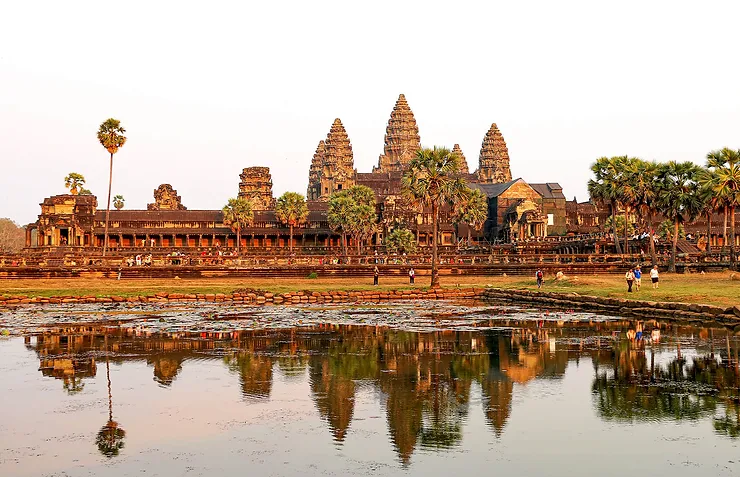

Getting up early was worth it to see the temples of Angkor Wat at dawn
What surprised me most was the lack of care and respect for the facilities and ruins, both on the part of tourists and those responsible for managing and protecting the temple. They were the ruins of temples that dated back more than 1,000 years and housed 800,000 people, making Angkor Wat (by far) the most populated city of antiquity. However, now there was a huge mass of tourists climbing the rocks, touching all the sculptures, sitting to eat and drink in rooms of the temples and other various atrocities that it was impossible for me to understand that local management would allow on its heritage. And in fact it was not like that, because after investigating a little later I discovered that the Government of Cambodia had transferred the concession to an oil company that billed 25 million dollars annually for the management of Angkor Wat and paid only 1 million annually to the Government. from the country. Obviously, the conservation of the ruins is not among their priorities.
The place itself is prodigious, extraordinary and it is difficult to conceive that such a beautiful and captivating place was built more than 1,000 years ago. One of the most notable aspects is the way it integrates over the years with the forest that now floods the entire area. The circuit to visit the most relevant temples is 20 kilometers, the vast majority of visitors travel by tuc-tuc (local motorized transport) and a few by bicycle. I did it walking. Although the main temples were overcrowded, that did not prevent us from contemplating its extreme beauty. I also enjoyed walking through the forest of the enclosure, even discovering small villages of cabins and temples camouflaged in the density of the trees where there was not a single visitor.
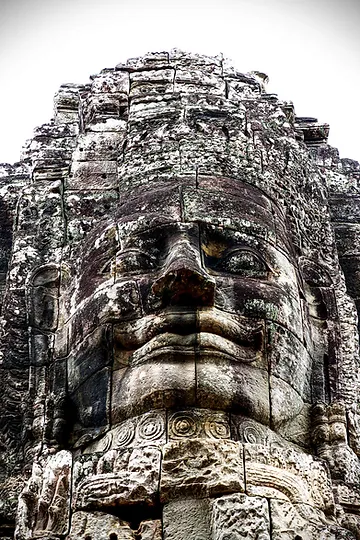

The temples of Angkor Wat are full of stone art


"Cheaper than Mercadona hears!"
A common factor could be seen with the rest of the tourist attractions in Asia; the local street vendors stubborn in convincing you to purchase any type of item. However, in this case there was an astonishing circumstance and that is that many of them managed a basic vocabulary in a large number of languages. Thus, if you stopped to observe a seller for a moment, you could see him offer his product in English and then, after trying to find out the origin of the specific tourist, ask him how it is in French, Chinese, Japanese or even Spanish, to the point that I witnessed how some Spanish tourists passed by the stall of a seller of art prints and when answering “Spanish” to their question about their origin, she exclaimed “buy! Cheaper than Mercadona!” In this case, the perplexed countrymen had no choice but to turn around, smile… and end up succumbing to the charms of the local seller by purchasing one of her works.
The visit to the temples was an unforgettable experience, but not so rewarding was my first walk the next day through the city that houses them, Siem Reap, as it is completely commercialized and full of tourists who miss such a wonderful opportunity to discover. a new gastronomy and local traditions indulging in establishments where they eat Western food, drink European beer and just interact with other tourists.
After a short walk, I realized that having already visited the temples of Angkor Wat my time in Siem Reap would end the next day, but first I wanted to explore a little and discover the authentic aspect of a Cambodian village, so I prepared to walk in direction opposite to the two streets designed for tourism, a decision that turned out to be a great success.
The shock that the occupation carried out by Western influence in the center of the city had caused in me soon faded as I walked along dirt roads surrounded by wooden and reed cabins, observing the elders peacefully talking in groups while the children played. and they did their thing as they pleased.
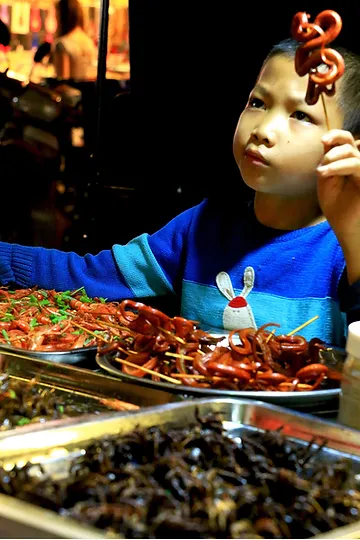

Boy selling snakes to tourists
After a while, I arrived at what at first glance seemed like an abandoned temple, but as I approached I discovered a group of people dressed in white sitting listening to the sermon of two Buddhist monks. I approached stealthily so as not to disturb the ceremony, although I soon perceived a festive and jovial atmosphere, so I began to graphically document the scene. I continued getting closer and to my amazement, after seeing a small wreath of flowers next to a photograph, I understood that it was a funeral. Looking around, I discovered a cremation pyre, where the body of the deceased was being cremated while the ceremony was taking place. How can I be sure of this? Minutes later I was fortunate to meet someone very special who carefully explained to me the details and philosophy behind the rite I had just witnessed.
I continued walking and entering that mysterious location until I reached a small town of wooden houses where I saw the orange cloths typical of Buddhist monks hanging from several ropes. After walking around, I found a young monk playing with some puppies and I approached him to talk. Amazingly, he communicated perfectly in English and I was able to enjoy an interesting and enriching conversation with him.
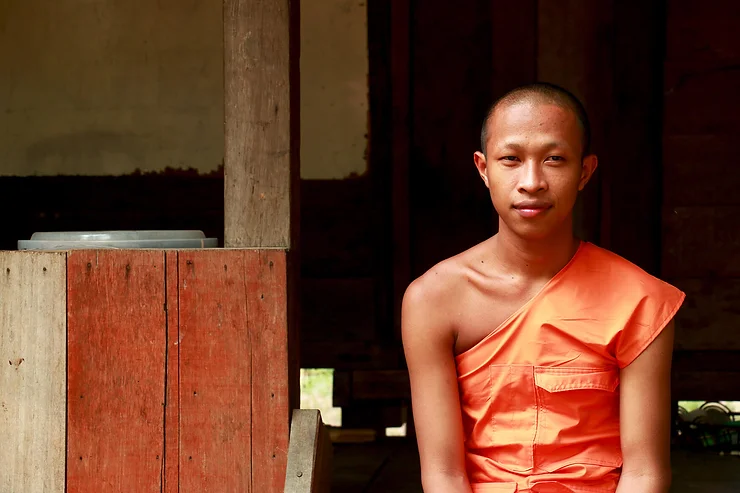

Rathana Asous, Tibetan Buddhist monk, student of life
His name is Rathana Asous and he is 22 years old, 10 of the last ones working as a Buddhist monk. He told me that this small village is called Wat Bo and there live 148 monks who attend a Buddhist school and spend practically all the rest of their time studying. Rathana shares his room with two other monks and explains to me that they live very humbly here, but he is tremendously grateful to the people who, through his donations, make it possible for this village to exist. In a certain way, people contribute so that the monks have decent living conditions and can study and train, while on the other hand, they are rewarded by being able to consult and ask for advice from the monks, chat with them and have their tutelage. in rites and ceremonies.
His family lives in a very humble village and they sent him to this town so that he would have the opportunity to study and learn, although he only has the opportunity to visit them once a year. When talking about the rite that he had just witnessed, he confirmed to me that it was a funeral and that they actually cremate the body of the deceased while the ceremony is being held and then deposit the remains in one of the pagodas. When I asked him how it was possible that all the attendees were dressed in white and there was an air of joviality to say goodbye to a young man who had died, he smiled at me and said that for them death is not the end, but the beginning of a new beginning. , of another new life, part of a process that is repeated indefinitely until reaching Nirvana.
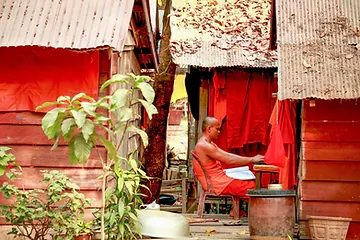

After Siem Reap, I wanted to discover what the Cambodian coast looked like, so I drove to Sihanoukville, where I stayed in a local hostel and rented a motorbike from a bar owner to discover uninhabited beaches beyond civilisation. Once again the feeling was bittersweet, because despite being a beautiful place that housed virgin beaches of fine sand and turquoise waters, one could also perceive the breath of a crushing imperialism that advanced without any complexes. A clear example of this was the bridge that leads to Kohpuos Island. Since I arrived, its spectacular presence caught my attention, so I went there with the intention of crossing it and discovering something else. To my surprise, the bridge, despite being completely completed, was closed to traffic, a fact that aroused my suspicions. I had to find out more about it.
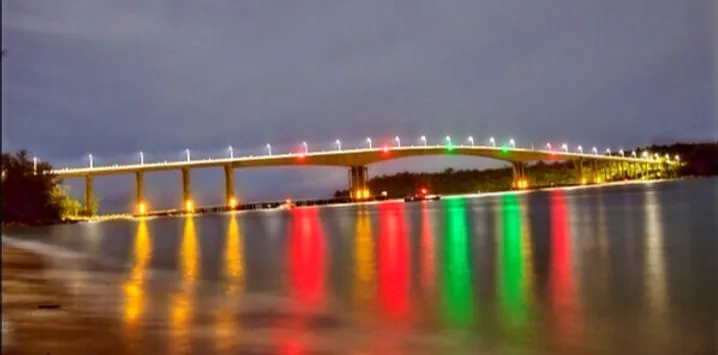

Bridge to Kohpuos Island
I went to the place that always works when a deep and sagacious investigation is required: the bar. After sharing a couple of beers with locals and senior foreigners settled in the city, I dropped the topic and they shared with me the history of the bridge and the island that I was later able to verify from reliable sources.
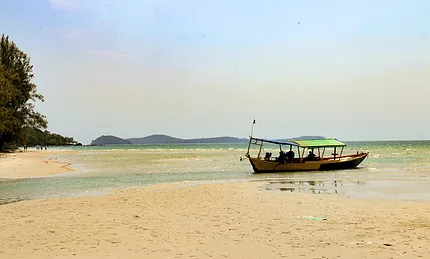

The beaches of Otres are spectacular
Kohpuos Island, to which the bridge leads from Sihanoukville, turns out to be a true paradise on earth, combining a dense tropical forest and rich animal life with dreamlike virgin beaches…unfortunately a panorama too beautiful to last. A Russian investment group obtained the concession of the island for 99 years with the promise of “developing” the area. Well, basically what they have done has been to build a luxurious and modernist bridge to close it to the public while they build and destroy the natural habitat at will with the aim of preparing an island full of pompous and opulent restaurants, resorts and shopping centers to attract to high-end tourism. And I wonder, if they destroy and transform a natural paradise that was previously enjoyed by locals into a tourist location where all the businesses will be controlled by Russian magnates, from what point of view can this be called “development” for Cambodia? But in addition, the main investor of the group that obtained the concession of the island, Alexander Trofimov, was found guilty of sexually abusing no less than 17 minors, for which he was sentenced to as many years in prison of which only He has served 3 of them before being granted a ‘Royal Pardon’ and deported to Seoul.
After discovering how natural beauty and controversy dance hand in hand in Sihanoukville, I traveled to Kampot, rented a motorcycle and entered a natural park looking for an abandoned French ghost town of which barely anything remains.
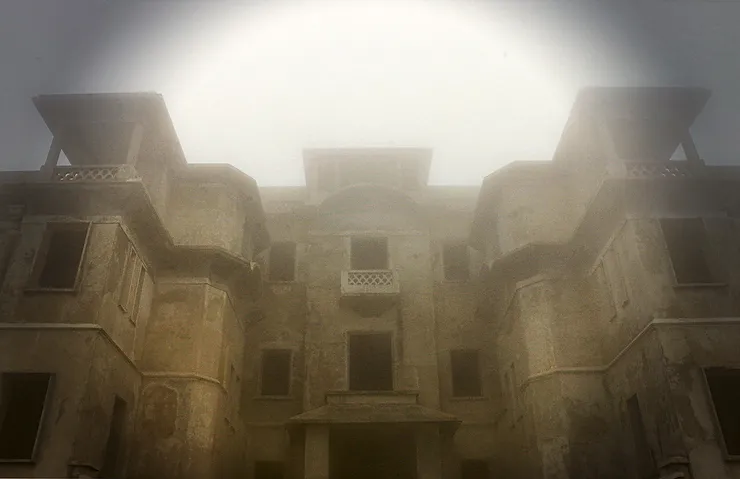

I was lucky enough to visit the ghost town of Kampot...covered in fog!
Finally, before returning to Thailand, I spent the night in Battambang, rented a motorcycle again, drove for almost an hour and asked locals until I finally found the home of the largest species of the only flying mammal: the bat fruit giant or as it is commonly called, megabat. It was one of those moments in which despite creating high expectations, they were far exceeded.
I knew they were large animals, but when I was able to witness them up close, their appearance was truly striking. It is intimidating to see them fly 3 or 4 meters above, accompanying their flight with an imposing shadow beneath them. Their wingspan ranges between 1.20 and 1.80 meters and, as their name indicates, they feed on fruit. Furthermore, the peculiarity of this place is that although there are hundreds of trees in the area, all the bats are distributed in the three that are located at the entrance to the Buddhist temple of Wat Baydamram, a fact that fuels the local myth about monks. and megabats protecting each other.
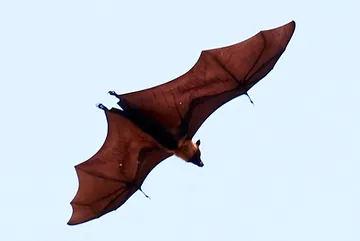

Megabat!
Without a doubt, the adventure through Cambodia has been a pleasant and enriching experience in which, above all, I have enjoyed contact with the friendly and smiling local inhabitants, as well as, as soon as I managed to escape the city a little, pure and wild nature. However, the feeling of rage and helplessness is inescapable after witnessing how once again the ambition and greed of a few is capable of having such a devastating influence on the culture, traditions, way of life and, ultimately, the home of a number. so big of people. But I am left with the most important part of the reflection, and that is that there are only a few and at the end of the day I am certain that the way in which we direct our consumption and way of doing tourism is what sustains or discredits this type of imperialist investments and behaviors. Witnessing these realities motivates and inspires me to convey the message that everything is changing, because if they are a few, we are many and we are increasingly aware of our responsibility, we are realizing that a better world is possible and that the answer is in us.
